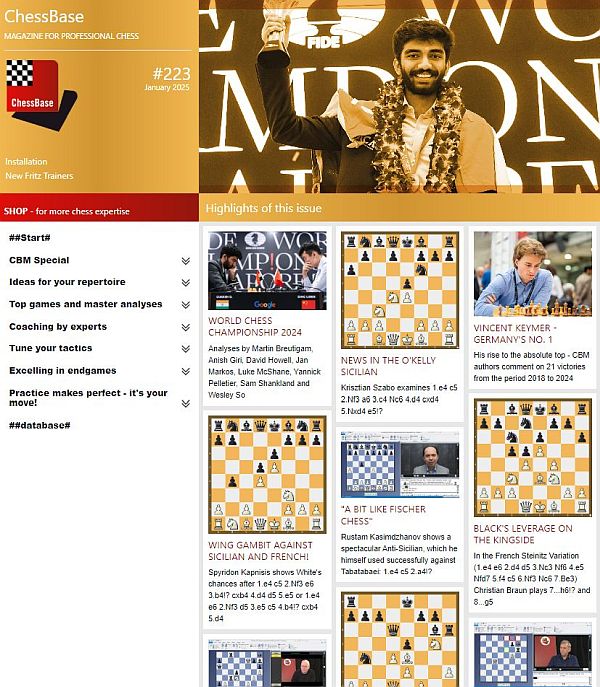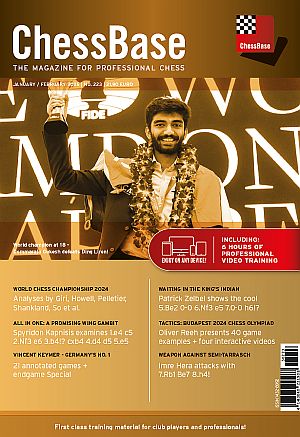.jpeg)

.jpeg)
The Semi-Tarrasch (1.d4 Nf6 2.c4 e6 3.Nc3 d5 4.cxd5 Nxd5) has seen a resurgence since 2013, largely thanks to the efforts of Vladimir Kramnik, the "godfather" of recent opening theory. Black avoids the notorious Carlsbad structure, and its soundness, combined with simplicity, attracted many players. Therefore, it didn't take long for White to come up with some "Anti-Semi-Tarrasch" attempts, one of them being 5.e4 Nxc3 6.bxc3 c5 7.Rb1!?, which can be labelled as the starting position of this article.
White, being the one with more space, prevents the liberating ...cxd4 & ...Bb4+, but the rook can also become useful on the b-file. In the first few top-level outings of 7.Rb1 Black tried 7...cxd4 8.cxd4 Nc6, but White has a couple of ways to put Black under some pressure, see the notes to Cumming,R - Barp,A 1/2.
The trend later shifted to 7...Be7 and 8.Nf3 0-0, when White normally continued developing with 9.Bc4 with a more positional battle ahead. It was only in 2018 when Karjakin uncorked the AlphaZero-esque 9.h4!? and won convincingly against Kramnik himself. This pawn advance ('Pushing Harry') is the main topic of the article and its main "patron" these days is Alexei Sarana.
Before checking the games, I would like to mention that I witnessed two encounters during the Hungarian Rapid Championship (which was part of a strong international open) in which White employed this setup and achieved crushing positions early on. It coincided with the first couple of games when I played the Semi-Tarrasch as Black, so after the tournament I immediately jumped on the topic and delved deep into it. Those games (Gledura - Papp and Svidler - Maghsoodloo) are discussed in Sivuk,V - Merario Alarcon,A 1-0.
But first let's discuss what happens if White foregoes Nf3!
A) 8.h4!? 0-0 9.h5 h6 10.Qg4!?
White brings out the most powerful (attacking) piece before anything else, which is the point of leaving the knight on g1. Indeed, it looks dangerous, but after the calm 10...Kh8! White has his own issues: a hanging pawn on d4 and the threat of opening the diagonal with e6-e5! Logical is 11.e5, when precision is required from both players. The most forcing continuation - not surprisingly - leads to perpetual check, although both sides can avoid it if they really wish ,with unclear outcomes. See Cumming,R - Barp,A 1/2.
B) 8.Nf3 0-0 9.h4!? cxd4 (or 9...Nc6 10.h5) 10.cxd4 Nc6 11.h5
What made writing this article somewhat tougher than usual is the enormous number of transpositional possibilities. Black can include ...cxd4 basically every move, starting from move 7. Sometimes it makes a difference, sometimes it doesn't. I tried my best to cover and explain them well. Therefore, it makes sense to differentiate between certain plans and not just moves only. "Big Vlad" chose an early ...Nc6 against Karjakin in the aforementioned game. It puts pressure immediately on White's centre, but on the other hand it blocks Bb7-Bxe4 and the knight can also become a target (see for example Giri - Wei Yi in the notes after 9...Nc6 in Karjakin,S - Kramnik,V 1-0). Black's best with a knight already on c6 is to stop White's avalanche with 11...h6 and strike only after 12.Be2! b6 13.Rh3 f5!, when perhaps White is still for preference at the end of a complicated line, but Black survives. Instead, Kramnik played the impulsive 11...f5?! and was outplayed beautifully. Karjakin,S - Kramnik,V 1-0 was analysed in great detail by Marin, but I added a few comments where I felt it was necessary, especially after 9...Nc6 10.h5 h6.
C) 8.Nf3 0-0 9.h4 b6 10.h5 Bb7!? (or 10...cxd4 11.cxd4 Bb7!?)
Another brave possibility is shown in the diagram. Black invites White to push their pawn all the way up to h6, but it means that immediate attacking chances decrease. On the other hand, the little guy on h6 can become a long-term headache for Black (weakened dark squares, many endgames are much worse). The critical position arises following 11.Bd3! cxd4 12.cxd4 Nc6 13.h6 g6 (or any other move order, as more than one road leads to Rome).

White has a choice: 14.Bb5!?, the move I chose during the pandemic, 14.Be2!?, which might be the trickiest and 14.Bb2, the move played in Sivuk,V - Merario Alarcon,A 1-0. Black is objectively okay, but needs to defend like a machine, so it's no surprise that White scores heavily in this sub-line.
D) 8.Nf3 0-0 9.h4 b6 10.h5 h6 11.Rh3 Bb7?! (or 11...cxd4 12.cxd4 Bb7?!)

As strange as it may sound, Black shouldn't follow up ...b6 with developing the bishop immediately, as they will lack the e6-e5 freeing break, shown in Line E). Perhaps even stranger is that White shouldn't rush with 12.Rg3, but should stay flexible with 12.Bd3!. Its reasoning, and why including the exchange on d4 in this particular position hurts Black even more is explained in Rodshtein,M - Stefansson,V 1-0. After move 15 the following position was reached:
.jpg)
White is about to deliver a decisive blow on g7, but can also open the long diagonal soon with d4-d5. It turns out that the knight is useless on c6, as taking on d4 is a suicide and it's badly missed from the kingside (had it been on f6, it would be a completely different story). White finished the game in great style.
E) 8.Nf3 0-0 9.h4 b6 10.h5 h6 11.Rh3 Nd7

Flexibility was crucial in the previous line and the same can be said here. Depending on White's reply, Black can still play ...Bb7, but also strike in centre with a timely e6-e5 (for example 12.Bd3 is met with 12...cxd4 13.cxd4 e5!). To prevent that White can play 12.e5 themself, which is followed by 12...cxd4 13.cxd4 Bb7 14.Rg3 (or 14.Bd3 Rc8) Kh8 15.Bd3 Rc8.

Black has activated his forces and wants to strike with f7-f5 again, although here it's mostly played with defensive purposes. Black shares equal chances and went wrong only later in Gharibyan,M - Poysti,N 1-0.
A more direct attempt is 12.Rg3 Kh8 13.Qd2!?, hinting at Rxg7 again. It was played against me by the strong theoretician and CBM author, Héra Imre. Here I was happy to show my home analysis with 13...cxd4!.
.jpg)
White can either sacrifice the rook here or after 14.cxd4 Bb7, but Black hangs on in both cases, although they have to go through some scary moments and be extremely well prepared. Luckily I was, see Hera,I - Csonka,B 1/2.
Conclusion: The Anti-Semi-Tarrasch with 7.Rb1 scores well for White (especially after 9.h4!?) and I can see it as a reason why many Black players play the Nimzo-Indian against 3.Nc3 and only enter the Semi-Tarrasch after 3.Nf3 d5 4.Nc3 c5. Having said that, Black isn't without counter-resources. While I suggest you avoid the early 7...cxd4 8.cxd4 Nc6 and Line C, which doesn't fare well in human chess, chances shouldn't be underestimated in Line B, although they have to wait with f7-f5 for the appropriate moment. Objectively best is the flexible 7...Be7 8.Nf3 0-0 9.h4 b6 10.h5 h6 11.Rh3 Nd7, when White's margin for error is lighter, but Black is okay if they know what they're doing. One thing is for sure: this line isn't for faint-hearted for either colour!
The start page of ChessBase Magazine #223 as a ChessBase Book. The menu on the right takes you to all the articles, analyses and videos of the issue.
Total playing time of the videos: Over 6 hours!
From the World Chess Championship 2024 to Oliver Reeh's ‘Olympic Combinations’ and Dorian Rogzenco's ‘The Fortress’ to ‘Fundamental Endgame Knowledge’ with Dr Karsten Mueller:

Over 6 hours of video playing time with Rustam Kasimdzhanov, Daniel King, Jan Markos, Karsten Müller, Oliver Reeh, Robert Ris and Dorian Rogozenco!
World Chess Championship 2024: All games with analyses by Giri, Howell, Shankland, So and others - ‘World Championship Special’: Dorian Rogozenco sheds light on the decisive moments of the match in his video analysis - ‘All in One’: A wing gambit against Sicilian and French! - ‘Show your inner Gukesh!’: Replay the victory of the new world champion against Fedoseev from the 2024 Chess Olympiad move by move with Robert Ris!- ‘Olympic Combinations’: Oliver Reeh's tactics column with 40 games and four interactive videos - ‘Black's Leverage on the Kingside’: In the French Steinitz Variation Christian Braun plays 7...h6!? and 8...g5 and much more.

Order now in the ChessBase Shop – Single issue € 21.90!
Try out ChessBase Magazine now! Order the ChessBase Magazine taster package!
Read ChessBase Magazine for 6 months (= 3 issues) for the special price of only € 44.90 € (instead of € 65,70 for buying them individually). As a thank you, you will also receive 3 months ChessBase Premium Membership free of charge.
*Bonus for new subscribers only, i.e. there was no CBM subscription for 12 months!
Save twice with ChessBase Magazine: For the annual subscription to ChessBase Magazine you’ll pay only € 109.90 per year (compared to € 131.40 for the 6 individual issues).
* Bonus only for new subscribers, i.e. there was no CBM subscription for 12 months! As a new subscriber you will receive a 20 Euro voucher for the ChessBase Shop!
| Advertising |